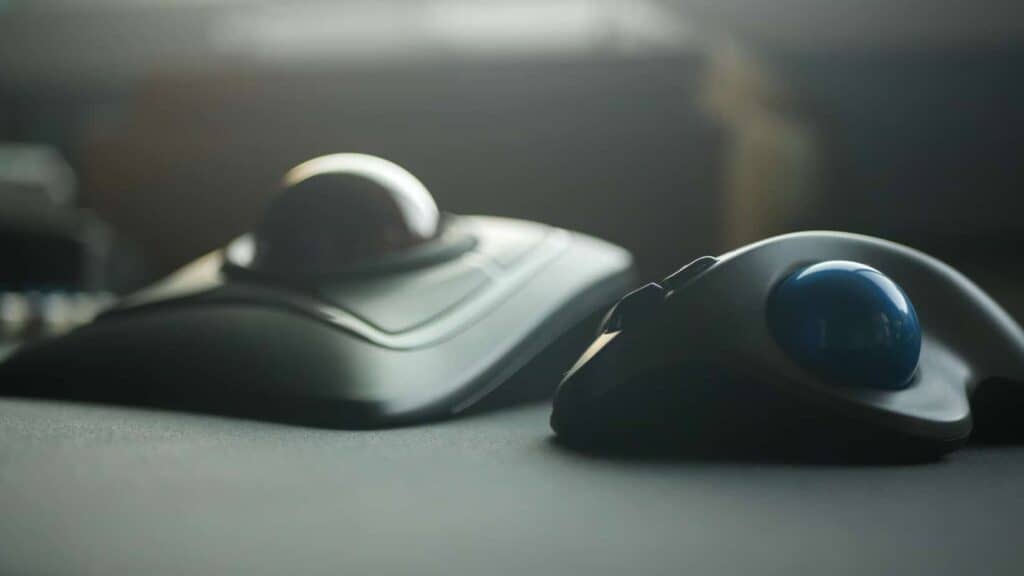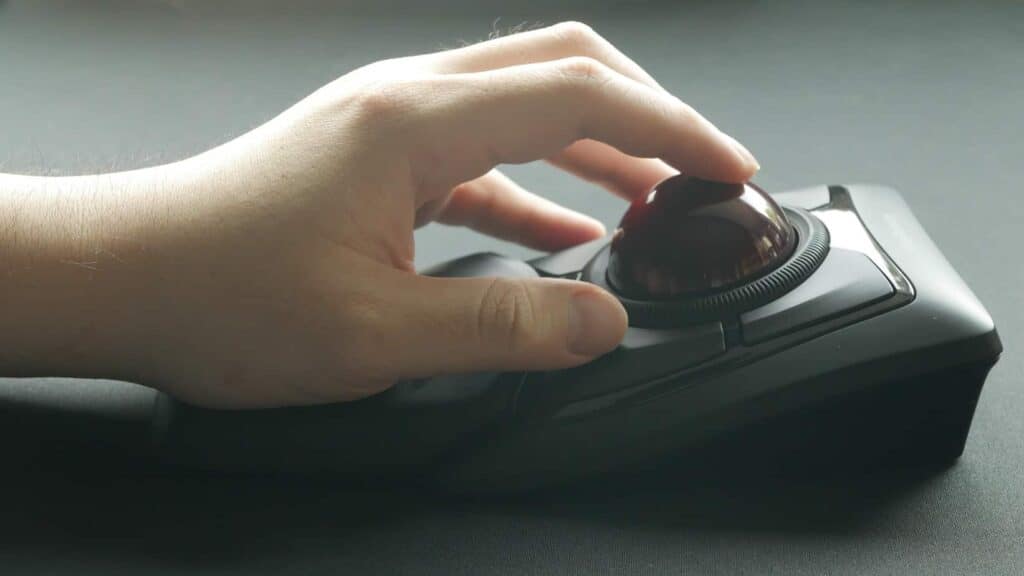If you’re considering a trackball mouse, you might be wondering…can I play games with one of those too?
The answer is yes…kind of. It depends on the game you’re playing, and what you demand from a gaming peripheral.
There is no denying that a quality gaming mouse is the proven choice for professional gamers and those who demand speed, precision, and predictability in a mouse, but a trackball might surprise you.
Let’s take a closer look at the differences between a trackball and gaming mouse to see if you should consider rolling over the competition.
Can You Game with a Trackball Mouse?

Yes, you can game with a trackball, the same way that you can game with any non-gaming mouse, but due to the learning curve it’s mostly only recommended for casual games.
Gaming with a trackball will take some getting used to and is not really recommended for games that require speed and precision like FPS or RTS.
If you have only ever used a laser mouse or gaming mouse before, and demand precision in your gaming peripherals, you may feel a trackball is clumsy at first.
For casual games, RPGs, and simulators, a trackball is perfectly fine.
Because of its simpler layout and ergonomic design, a side-mounted, thumb controlled trackball may be better for gaming.
It will feel more familiar, and will allow you to use your fingers the same way as a gaming mouse.
If you want to learn more about top vs side-mounted, check out this article about Thumb vs Finger Trackballs.
Once you get comfortable and familiar with the nuances of a trackball, the world is at your fingertips.
Two big disadvantages that trackballs have compared to gaming mice is the lack of both on-the-fly adjustable DPI and adjustable high polling rates.
Trackball Mouse vs Gaming Mouse
Let’s take a closer look at the advantages and disadvantages of both types by examining the DPI, polling rate, and other fun aspects of each type.
DPI
DPI, or dots-per-inch, is the measurement used for adjusting mouse sensitivity.
A higher DPI is a hallmark of modern gaming mice, some exceeding 25,000 DPI for a ridiculously high sensitivity and efficiency in movement.
Most gaming mice also offer on-demand adjustments through programmed buttons on the mouse.
In many competitive games, it is common to use higher sensitivity for general movement, but much lower DPI for ultra-precise movement, as low as a few hundred.
When you have higher sensitivity, this means you don’t have to move the mouse nearly as far to achieve the same cursor movement on your display.
Typically, though, higher DPI means less precision and less control.
On a trackball, it could lead to too much sensitivity.
You may find that when using a trackball, you don’t necessarily need all the extra sensitivity. In fact it might be harder to use.
As the sensor reads the surface of the ball itself, having DPI as high as 25,000 DPI would make even the slightest touch to register a large cursor movement and make it difficult to control.
Try turning on mouse acceleration when using a trackball for gaming. It could give you added precision for smaller movements, but still allows for large sweeping movements as well.
High DPI On a Trackball?
There are a few trackballs with “gaming sensors” that do provide higher levels of sensitivity, but rarely exceeding 1500 DPI.
But would you really want high DPI on a trackball? No. As it turns out, probably not a good choice.
A gaming sensor on a traditional mouse requires high DPI because the surface area is much greater than that of a trackball.
Assuming your average mouse pad is 80 square inches, the surface area of a 2-inch trackball is considerably smaller.
If you had a 25k DPI sensor on something the size of a trackball, even the smallest movement could cause a huge cursor jump. This means no control, no precision, and no way to use it as a gaming mouse.
A fraction of the DPI would be more than enough to get the same level of sensitivity.
Polling Rate
Polling rate, measured in herz or “hz”, is the frequency at which the peripheral reports data back to your computer.
Herz can be converted to speed measured in milliseconds or “ms”.
125hz is the speed of 8ms, and 1000hz is a speed of 1ms.
In this case it means how often your mouse sends clicks and navigation data from the switches, scroll wheel, and sensor.
This is especially important if your polling rate is lower than your monitor’s refresh rate, for example using a 125hz polling rate mouse on a monitor with 144hz or greater refresh rate.
While it would be fine on a 60hz to 120hz monitor, you may start to notice a drop in smoothness when exceeding the limits of your mouse.
If precision input, movement, and timing are crucial for your gaming, then it is best to ensure you have not only adjustable DPI, but options for higher polling rate as well.
Gaming mice nowadays have polling rates in the thousands, in some cases like the upcoming Razer Avalon, up to 8,000hz or 1/8 of a millisecond.
Trackballs, however, usually have a significantly lower polling rate, usually hovering around the 125hz on average to 250hz on the higher end. At best, still a fraction of the speed that even basic gaming mice offer.
Smoothness

How smooth and easy a gaming mouse is to use is typically dependent on 3 factors: weight, glider/skate smoothness, and cable drag.
With a trackball, none of this is relevant. Rather, a trackball’s usability is determined by the size of the ball itself, and the smoothness of the small trackball bearings.
Weight vs Trackball Size
Gaming mice are getting lighter and lighter.
While some premium options allow you to control heaviness with added weights, others take extreme measures to drop weight faster than a fighter before weigh-ins.
Gaming mice can range anywhere from a 200 grams on the heavier side to under 56 grams in some lighter options.
Some trackball globes weigh more than entire gaming mice. With trackballs, weight of the overall unit can define build quality and sturdiness.
What will make it difficult to move is the size of the ball.
Though bigger hands may not have as much of a problem with larger trackballs, all hands will still require a greater range of motion than smaller ones.
If you have a smaller hand, or a trackball with awkward layout, you may not be able to click and move simultaneously.
Cable Drag and Gliders vs Bearing Friction
Cable drag and Glider smoothness are two big factors when it comes to how easy your gaming mouse is to control.
Sometimes a cable can seem heavier than the mouse.
Other than going wireless, your only real option is a cable tether to elevate it and cut you some slack every once in a while.
The glider skates on the bottom of the mouse help cut down on friction and can be made to be extremely smooth, but they may require some upkeep and an equally smooth desk surface.
Cables? Trackballs don’t need no stinking cables. Skates are for kids and hockey players.
You must rely solely on your thumb or fingers to move what is hopefully a smooth trackball over smooth bearings.
Some feel weightless, while others feel like you’re just rubbing plastic on plastic.
Well, the reason for that is because you are rubbing plastic on plastic. Tiny little balls of plastic.
Any friction or drag from a dead-stop could cause unpredictable movements, and smaller diameter trackballs may not offer enough cursor movement with a single roll.
On one hand, less smoothness could mean you are more mindful and intentional in your cursor movement.
On the other hand, this could mean more effort to achieve the same movement, and more strained fingers.
You can always mod your bearings to be metal or even “artificial ruby” plastic, but you may void your warranty, or literally lose your bearings.
Accessibility
A gaming mouse more familiar and easier to control for most people. But about those that can’t use a regular mouse to begin with?
If you can’t hold a mouse and control it with your fingers, how can you use a computer pointing device, let alone game with one?
With a trackball, especially a top-mounted trackball, you don’t need hands. You don’t need fingers. You just need to be able to roll and click.
Larger diameter, central trackballs are easily to control and you can find buttons arranged in a variety of layouts that best suit your needs, for better ergonomics, control, and overall ease-of-use.
If a mouse isn’t an option for you, perhaps a trackball can be.
Conclusion
In the end, you can most definitely use a trackball for gaming.
Whether you should, however, is up to you to decide.
A question you should ask yourself is: would you rather trust the movement in this game to your hand, arm, and joint movement? Or can you afford to let just your thumb or fingers to the work for you?
Though a trackball could make some games even more enjoyable and accessible, it may not be the best option for you.
If what you seek is an alternative to the traditional point and click mouse, maybe you should roll with a trackball.
If you think a gaming mouse might be a better choice for you, check out this article to see if a gaming mouse is worth it.
Thank you for reading, and game on.
